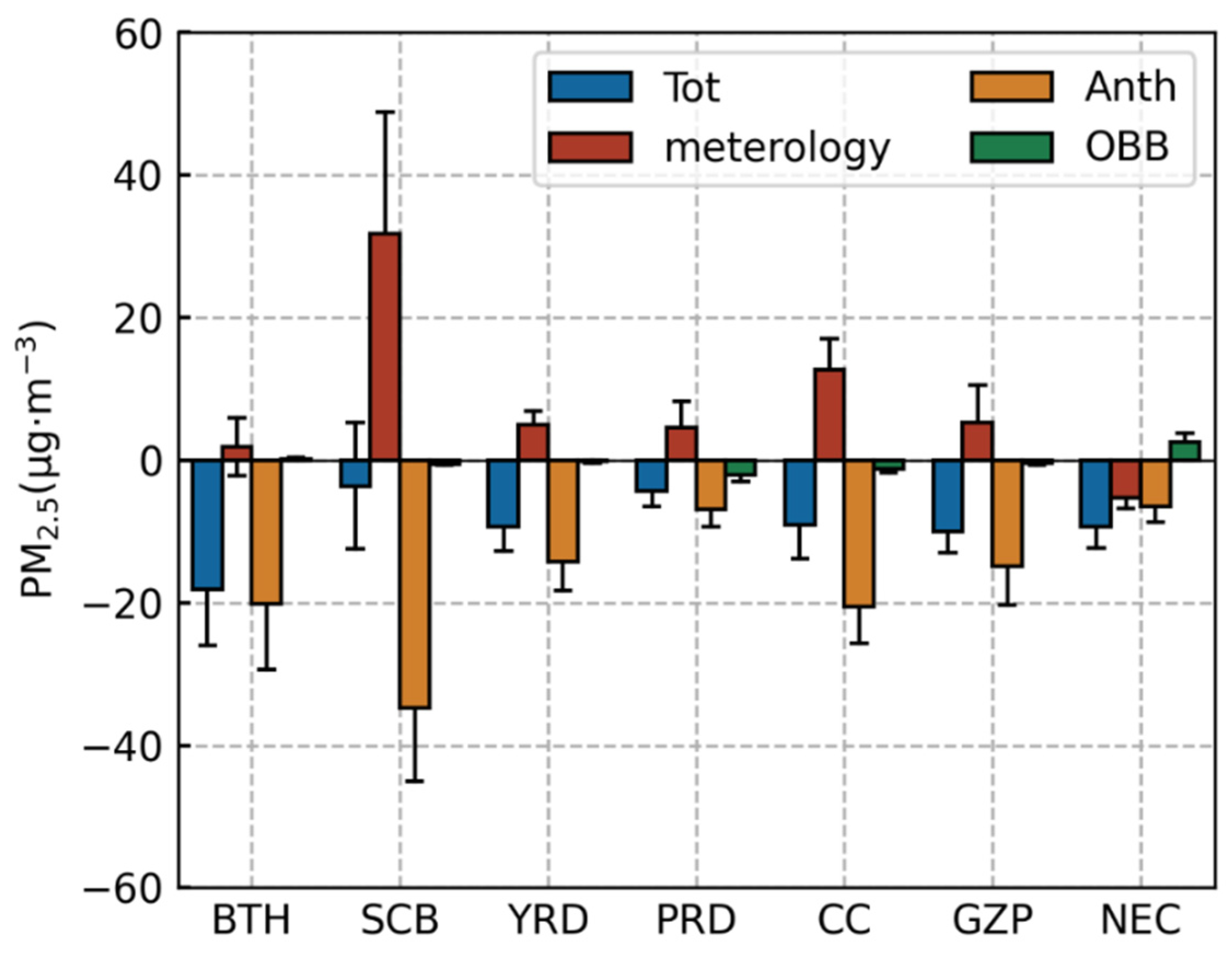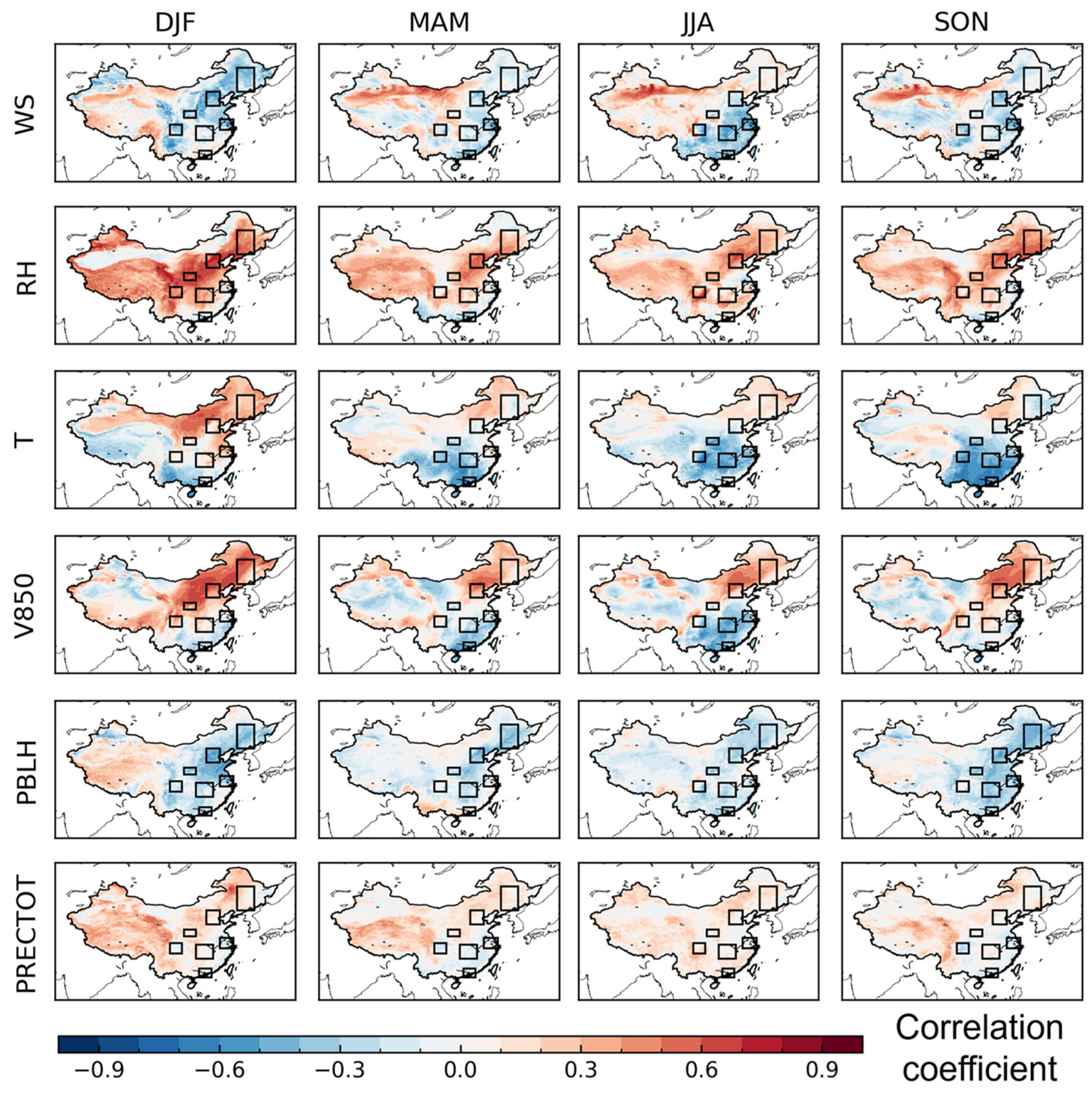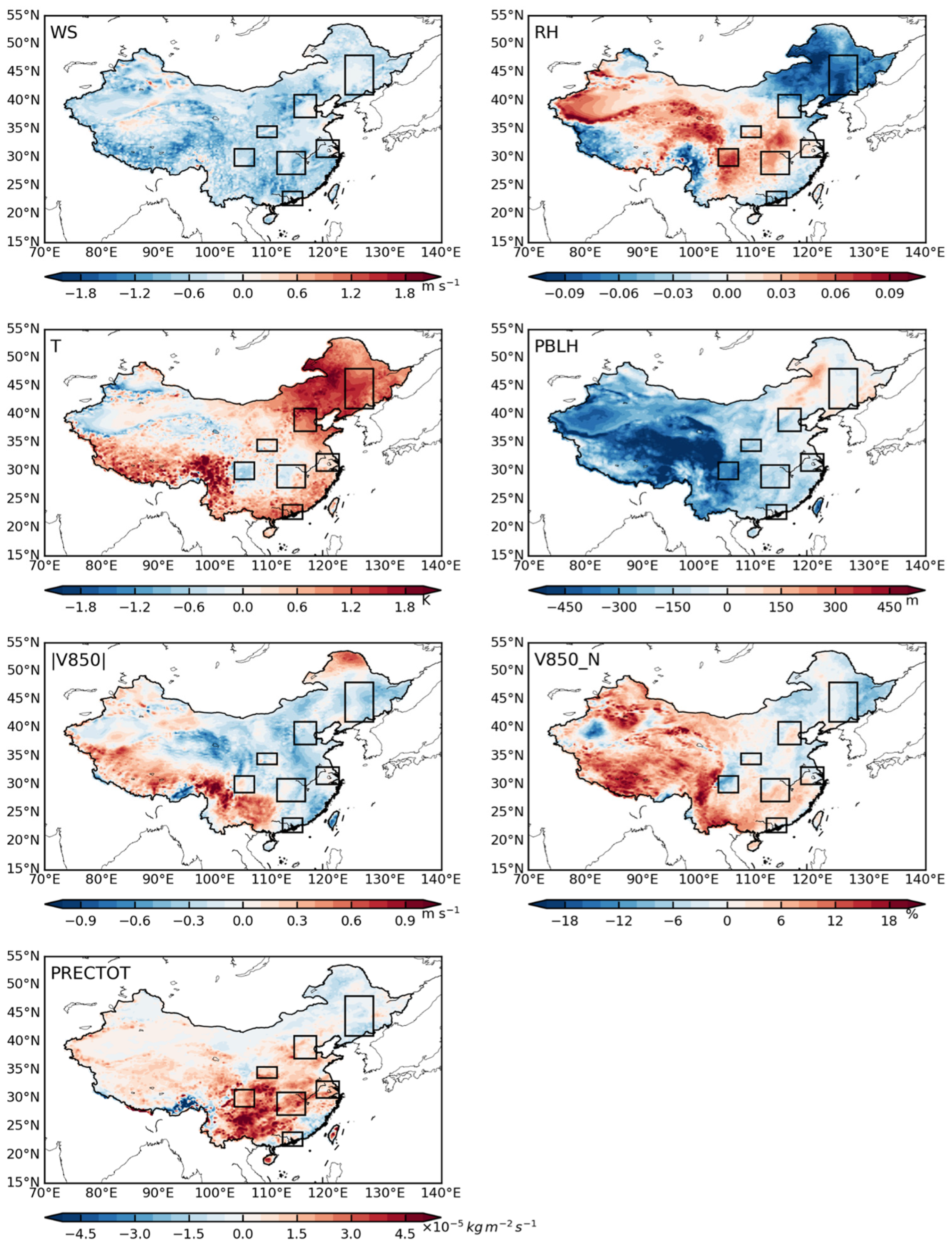Varying Drivers of 2013–2017 Trends in PM2.5 Pollution over Different Regions in China
Abstract
1. Introduction
2. Data and Model Description
3. Results
3.1. Simulated Trends in PM2.5 Concentrations in Comparison with Observations
3.2. Factors Controlling the Trend of PM2.5 Pollution in China
3.2.1. The Role of Emission Variations
3.2.2. The Role of Meteorology
4. Conclusions
- (1)
- The largest reduction in PM2.5 due to emission controls is found in SCB (35 ± 10 μg m−3, 35%), followed by CC (21 ± 5.1 μg m−3, 27%), BTH (20 ± 9.2 μg m−3, 26%), GZP (15 ± 5.3 μg m−3, 23%), YRD (14 ± 4.0 μg m−3, 23%), PRD (6.9 ± 2.5 μg m−3, 19%), and NEC (6.6 ± 2.2 μg m−3, 17%).
- (2)
- The changes in all regions, except for NEC, are larger than the total change in PM2.5, implying an opposite effect from other factors, e.g., meteorology. Although the change due to emission controls in NEC is less than the total change, it still accounts for 70% of the total.
- (3)
- While emission reduction controls the trends of PM2.5 in eastern China, its effect in western China is small, around one-third of the total change.
Author Contributions
Funding
Data Availability Statement
Conflicts of Interest
References
- Yan, R.C.; Yu, S.C.; Zhang, Q.Y.; Li, P.F.; Wang, S.; Chen, B.X.; Liu, W.P. A heavy haze episode in Beijing in February of 2014: Characteristics, origins and implications. Atmos. Pollut. Res. 2015, 6, 867–876. [Google Scholar] [CrossRef]
- Zhang, T.; Chillrud, S.N.; Ji, J.; Chen, Y.; Pitiranggon, M.; Li, W.; Liu, Z.; Yan, B. Comparison of PM2.5 Exposure in Hazy and Non-Hazy Days in Nanjing, China. Aerosol Air Qual. Res. 2017, 17, 2235–2246. [Google Scholar] [CrossRef] [PubMed]
- Liao, T.; Wang, S.; Ai, J.; Gui, K.; Duan, B.; Zhao, Q.; Zhang, X.; Jiang, W.; Sun, Y. Heavy pollution episodes, transport pathways and potential sources of PM2.5 during the winter of 2013 in Chengdu (China). Sci. Total Environ. 2017, 584, 1056–1065. [Google Scholar] [CrossRef]
- Pui, D.Y.H.; Chen, S.-C.; Zuo, Z. PM2.5 in China: Measurements, sources, visibility and health effects, and mitigation. Particuology 2014, 13, 1–26. [Google Scholar] [CrossRef]
- Ye, W.F.; Ma, Z.Y.; Ha, X.Z. Spatial-temporal patterns of PM2.5 concentrations for 338 Chinese cities. Sci. Total Environ. 2018, 631–632, 524–533. [Google Scholar] [CrossRef] [PubMed]
- Guascito, M.R.; Lionetto, M.G.; Mazzotta, F.; Conte, M.; Giordano, M.E.; Caricato, R.; Bartolomeo, A.R.D.; Dinoi, A.; Cesari, D.; Merico, E.; et al. Characterisation of the correlations between oxidative potential and in vitro biological effects of PM10 at three sites in the central Mediterranean. J. Hazard. Mater. 2023, 448, 130872. [Google Scholar] [CrossRef] [PubMed]
- Shindell, D.; Kuylenstierna, J.C.; Vignati, E.; van Dingenen, R.; Amann, M.; Klimont, Z.; Anenberg, S.C.; Muller, N.; Janssens-Maenhout, G.; Raes, F.; et al. Simultaneously mitigating near-term climate change and improving human health and food security. Science 2012, 335, 183–189. [Google Scholar] [CrossRef] [PubMed]
- Li, Z.Q.; Lee, K.; Wang, Y.S.; Xin, J.Y.; Hao, W.M. First observation-based estimates of cloud-free aerosol radiative forcing across China. J. Geophys. Res.-Atmos. 2010, 115, D00K18. [Google Scholar] [CrossRef]
- Su, W.; Loeb, N.G.; Schuster, G.L.; Chin, M.; Rose, F.G. Global all-sky shortwave direct radiative forcing of anthropogenic aerosols from combined satellite observations and GOCART simulations. J. Geophys. Res.-Atmos. 2013, 118, 655–669. [Google Scholar] [CrossRef]
- Zhang, Q.; Zheng, Y.; Tong, D.; Shao, M.; Wang, S.; Zhang, Y.; Xu, X.; Wang, J.; He, H.; Liu, W.; et al. Drivers of improved PM2.5 air quality in China from 2013 to 2017. Proc. Natl. Acad. Sci. USA 2019, 116, 24463–24469. [Google Scholar] [CrossRef]
- Feng, Y.; Ning, M.; Lei, Y.; Sun, Y.; Liu, W.; Wang, J. Defending blue sky in China: Effectiveness of the “Air Pollution Prevention and Control Action Plan” on air quality improvements from 2013 to 2017. J. Environ. Manag. 2019, 252, 109603. [Google Scholar] [CrossRef]
- Wang, Y.; Gao, W.; Wang, S.; Song, T.; Gong, Z.; Ji, D.; Wang, L.; Liu, Z.; Tang, G.; Huo, Y.; et al. Contrasting trends of PM2.5 and surface-ozone concentrations in China from 2013 to 2017. Natl. Sci. Rev. 2020, 7, 1331–1339. [Google Scholar] [CrossRef]
- Deng, M.; Chen, D.; Zhang, G.; Cheng, H. Policy-driven variations in oxidation potential and source apportionment of PM2. 5 in Wuhan, central China. Sci. Total Environ. 2022, 853, 158255. [Google Scholar] [CrossRef] [PubMed]
- Li, X.; Ma, Q.; Li, Y.; Wang, S. The Impact of the “Air Pollution Prevention and Control Action Plan” on PM2.5 Concentration in China During 2014–2019. In Proceedings of the 2021 IEEE International Geoscience and Remote Sensing Symposium IGARSS, Brussels, Belgium, 11–16 July 2021; IEEE: Piscataway, NJ, USA, 2021; pp. 1939–1942. [Google Scholar]
- Sun, Y.; Jiang, Q.; Wang, Z.; Fu, P.; Li, J.; Yang, T.; Yin, Y. Investigation of the sources and evolution processes of severe haze pollution in Beijing in January 2013. J. Geophys. Res.-Atmos. 2014, 119, 4380–4398. [Google Scholar] [CrossRef]
- Zhai, S.; Jacob, D.J.; Wang, X.; Shen, L.; Li, K.; Zhang, Y.; Gui, K.; Zhao, T.; Liao, H. Fine particulate matter (PM2.5) trends in China, 2013–2018: Separating contributions from anthropogenic emissions and meteorology. Atmos. Chem. Phys. 2019, 19, 11031–11041. [Google Scholar] [CrossRef]
- Feng, J.; Liao, H.; Li, Y.; Zhang, Z.; Tang, Y. Long-term trends and variations in haze-related weather conditions in north China during 1980–2018 based on emission-weighted stagnation intensity. Atmos. Environ. 2020, 240, 117830. [Google Scholar] [CrossRef]
- Liu, Z.Y.; Xue, W.B.; Ni, X.F.; Qi, Z.L.; Zhang, Q.Y.; Wang, J.N. Fund gap to high air quality in China: A cost evaluation for PM2.5 abatement based on the Air Pollution Prevention and control Action Plan. J. Clean Prod. 2021, 319, 128715. [Google Scholar] [CrossRef]
- Dong, L.; Leung, L.R.; Qian, Y.; Zou, Y.; Song, F.; Chen, X. Meteorological Environments Associated with California Wildfires and Their Potential Roles in Wildfire Changes during 1984–2017. J. Geophys. Res.-Atmos. 2021, 126, e2020JD033180. [Google Scholar] [CrossRef]
- Shen, H.; Tao, S.; Chen, Y.; Odman, M.T.; Zou, Y.; Huang, Y.; Chen, H.; Zhong, Q.; Zhang, Y.; Chen, Y.; et al. Global Fire Forecasts Using Both Large-Scale Climate Indices and Local Meteorological Parameters. Glob. Biogeochem. Cycle 2019, 33, 1129–1145. [Google Scholar] [CrossRef]
- Lima, C.H.R.; AghaKouchak, A.; Randerson, J.T. Unraveling the Role of Temperature and Rainfall on Active Fires in the Brazilian Amazon Using a Nonlinear Poisson Model. J. Geophys. Res.-Biogeosci. 2018, 123, 117–128. [Google Scholar] [CrossRef]
- Goss, M.; Swain, D.L.; Abatzoglou, J.T.; Sarhadi, A.; Kolden, C.A.; Williams, A.P.; Diffenbaugh, N.S. Climate change is increasing the likelihood of extreme autumn wildfire conditions across California. Environ. Res. Lett. 2020, 15, 094016. [Google Scholar] [CrossRef]
- Bey, I.; Jacob, D.J.; Yantosca, R.M.; Logan, J.A.; Field, B.D.; Fiore, A.M.; Li, Q.B.; Liu, H.G.Y.; Mickley, L.J.; Schultz, M.G. Global modeling of tropospheric chemistry with assimilated meteorology: Model description and evaluation. J. Geophys. Res.-Atmos. 2001, 106, 23073–23095. [Google Scholar] [CrossRef]
- Hudman, R.C.; Jacob, D.J.; Turquety, S.; Leibensperger, E.M.; Murray, L.T.; Wu, S.; Gilliland, A.B.; Avery, M.; Bertram, T.H.; Brune, W.; et al. Surface and lightning sources of nitrogen oxides over the United States: Magnitudes, chemical evolution, and outflow. J. Geophys. Res.-Atmos. 2007, 112, D12S05. [Google Scholar] [CrossRef]
- Eastham, S.D.; Weisenstein, D.K.; Barrett, S.R.H. Development and evaluation of the unified tropospheric–stratospheric chemistry extension (UCX) for the global chemistry-transport model GEOS-Chem. Atmos. Environ. 2014, 89, 52–63. [Google Scholar] [CrossRef]
- Marais, E.A.; Jacob, D.J.; Jimenez, J.L.; Campuzano-Jost, P.; Day, D.A.; Hu, W.; Krechmer, J.; Zhu, L.; Kim, P.S.; Miller, C.C.; et al. Aqueous-phase mechanism for secondary organic aerosol formation from isoprene: Application to the Southeast United States and co-benefit of SO2 emission controls. Atmos. Chem. Phys. 2016, 16, 1603–1618. [Google Scholar] [CrossRef]
- Park, R.; Jacob, D.; Kumar, N.; Yantosca, R. Regional visibility statistics in the United States: Natural and transboundary pollution influences, and implications for the Regional Haze Rule. Atmos. Environ. 2006, 40, 5405–5423. [Google Scholar] [CrossRef][Green Version]
- Park, R.j.; Jacob, D.J. Sources of carbonaceous aerosols over the United States and implications for natural visibility. J. Geophys. Res. 2003, 108, 4355. [Google Scholar] [CrossRef]
- Park, R.J.; Jacob, D.J. Natural and transboundary pollution influences on sulfate-nitrate-ammonium aerosols in the United States: Implications for policy. J. Geophys. Res. 2004, 109, D15204. [Google Scholar] [CrossRef]
- Pye, H.O.T.; Seinfeld, J.H. A global perspective on aerosol from low-volatility organic compounds. Atmos. Chem. Phys. 2010, 10, 4377–4401. [Google Scholar] [CrossRef]
- Li, M.; Zhang, Q.; Kurokawa, J.-i.; Woo, J.-H.; He, K.; Lu, Z.; Ohara, T.; Song, Y.; Streets, D.G.; Carmichael, G.R.; et al. MIX: A mosaic Asian anthropogenic emission inventory under the international collaboration framework of the MICS-Asia and HTAP. Atmos. Chem. Phys. 2017, 17, 935–963. [Google Scholar] [CrossRef]
- Zheng, B.; Tong, D.; Li, M.; Liu, F.; Hong, C.; Geng, G.; Li, H.; Li, X.; Peng, L.; Qi, J.; et al. Trends in China’s anthropogenic emissions since 2010 as the consequence of clean air actions. Atmos. Chem. Phys. 2018, 18, 14095–14111. [Google Scholar] [CrossRef]
- Anton, S.; Darmenov, A.M.d.S. The Quick Fire Emissions Dataset (QFED): Documentation of Versions 2.1, 2.2 and 2.4; NASA Technical Report Series on Global Modeling and Data Assimilation; NASA: Washington, DC, USA, 2015; Volume 38. Available online: http://gmao.gsfc.nasa.gov/pubs/docs/Darmenov796.pdf (accessed on 20 June 2024).
- Guenther, A.; Karl, T.; Harley, P.; Wiedinmyer, C.; Palmer, P.I.; Geron, C. Estimates of global terrestrial isoprene emissions using MEGAN (Model of Emissions of Gases and Aerosols from Nature). Atmos. Chem. Phys. 2006, 6, 3181–3210. [Google Scholar] [CrossRef]
- Tai, A.P.K.; Mickley, L.J.; Jacob, D.J. Correlations between fine particulate matter (PM2.5) and meteorological variables in the United States: Implications for the sensitivity of PM2.5 to climate change. Atmos. Environ. 2010, 44, 3976–3984. [Google Scholar] [CrossRef]
- Wang, Q.Q.; Jacob, D.J.; Spackman, J.R.; Perring, A.E.; Schwarz, J.P.; Moteki, N.; Marais, E.A.; Ge, C.; Wang, J.; Barrett, S.R.H. Global budget and radiative forcing of black carbon aerosol: Constraints from pole-to-pole (HIPPO) observations across the Pacific. J. Geophys. Res.-Atmos. 2014, 119, 195–206. [Google Scholar] [CrossRef]
- Action Plan on Air Pollution Prevention and Control. Available online: http://www.gov.cn/zwgk/2013-09/12/content_2486773.htm (accessed on 20 June 2024).
- Three-Year Action Plan on Defending the Blue Sky. Available online: https://www.gov.cn/zhengce/content/2018-07/03/content_5303158.htm (accessed on 20 June 2024).
- Zhang, L.; Gong, S.; Zhao, T.; Zhou, C.; Wang, Y.; Li, J.; Ji, D.; He, J.; Liu, H.; Gui, K. Development of WRF/CUACE v1. 0 model and its preliminary application in simulating air quality in China. Geosci. Model Dev. 2021, 14, 703–718. [Google Scholar] [CrossRef]
- Xie, X.; Ying, Q.; Zhang, H.; Hu, J. Spatial and Temporal Variations in the Atmospheric Age Distribution of Primary and Secondary Inorganic Aerosols in China. Engineering 2023, 28, 117–129. [Google Scholar] [CrossRef]
- Zhao, B.; Zheng, H.; Wang, S.; Smith, K.R.; Lu, X.; Aunan, K.; Gu, Y.; Wang, Y.; Ding, D.; Xing, J. Change in household fuels dominates the decrease in PM2. 5 exposure and premature mortality in China in 2005–2015. Proc. Natl. Acad. Sci. USA 2018, 115, 12401–12406. [Google Scholar] [CrossRef]
- Shao, P.; Tian, H.; Sun, Y.; Liu, H.; Wu, B.; Liu, S.; Liu, X.; Wu, Y.; Liang, W.; Wang, Y. Characterizing remarkable changes of severe haze events and chemical compositions in multi-size airborne particles (PM1, PM2. 5 and PM10) from January 2013 to 2016–2017 winter in Beijing, China. Atmos. Environ. 2018, 189, 133–144. [Google Scholar] [CrossRef]
- Tai, A.P.; Mickley, L.J.; Jacob, D.J.; Leibensperger, E.; Zhang, L.; Fisher, J.A.; Pye, H. Meteorological modes of variability for fine particulate matter (PM2.5) air quality in the United States: Implications for PM2.5 sensitivity to climate change. Atmos. Chem. Phys. 2012, 12, 3131–3145. [Google Scholar] [CrossRef]
- Chen, Z.; Xie, X.; Cai, J.; Chen, D.; Gao, B.; He, B.; Cheng, N.; Xu, B. Understanding meteorological influences on PM2.5 concentrations across China: A temporal and spatial perspective. Atmos. Chem. Phys. 2018, 18, 5343–5358. [Google Scholar] [CrossRef]
- He, J.; Gong, S.; Yu, Y.; Yu, L.; Wu, L.; Mao, H.; Song, C.; Zhao, S.; Liu, H.; Li, X. Air pollution characteristics and their relation to meteorological conditions during 2014–2015 in major Chinese cities. Environ. Pollut. 2017, 223, 484–496. [Google Scholar] [CrossRef] [PubMed]
- Han, Y.; Dai, X.; Fang, X.; Chen, Y.; Kang, F. Dust aerosols: A possible accelerant for an increasingly arid climate in North China. J. Arid Environ. 2008, 72, 1476–1489. [Google Scholar] [CrossRef]
- Lyu, Y.; Qu, Z.; Liu, L.; Guo, L.; Yang, Y.; Hu, X.; Xiong, Y.; Zhang, G.; Zhao, M.; Liang, B. Characterization of dustfall in rural and urban sites during three dust storms in northern China, 2010. Aeolian Res. 2017, 28, 29–37. [Google Scholar] [CrossRef]
- Chen, S.; Wang, W.; Li, M.; Mao, J.; Ma, N.; Liu, J.; Bai, Z.; Zhou, L.; Wang, X.; Bian, J. The Contribution of Local Anthropogenic Emissions to Air Pollutants in Lhasa on the Tibetan Plateau. J. Geophys. Res.-Atmos. 2022, 127, e2021JD036202. [Google Scholar] [CrossRef]
- Song, S.; Gao, M.; Xu, W.; Sun, Y.; Worsnop, D.R.; Jayne, J.T.; Zhang, Y.; Zhu, L.; Li, M.; Zhou, Z. Possible heterogeneous chemistry of hydroxymethanesulfonate (HMS) in northern China winter haze. Atmos. Chem. Phys. 2019, 19, 1357–1371. [Google Scholar] [CrossRef]
- Wang, X.; Wang, Q.; Prass, M.; Pöhlker, C.; Moran-Zuloaga, D.; Artaxo, P.; Gu, J.; Yang, N.; Yang, X.; Tao, J. The export of African mineral dust across the Atlantic and its impact over the Amazon Basin. Atmos. Chem. Phys. 2023, 23, 9993–10014. [Google Scholar] [CrossRef]
- Cai, W.; Li, K.; Liao, H.; Wang, H.; Wu, L. Weather conditions conducive to Beijing severe haze more frequent under climate change. Nat. Clim. Chang. 2017, 7, 257–262. [Google Scholar] [CrossRef]
- Su, T.; Li, Z.; Kahn, R. Relationships between the planetary boundary layer height and surface pollutants derived from lidar observations over China: Regional pattern and influencing factors. Atmos. Chem. Phys. 2018, 18, 15921–15935. [Google Scholar] [CrossRef]
- Liu, Z.; Shen, L.M.; Yan, C.Y.; Du, J.S.; Li, Y.; Zhao, H. Analysis of the Influence of Precipitation and Wind on PM2.5 and PM10 in the Atmosphere. Adv. Meteorol. 2020, 2020, 5039613. [Google Scholar] [CrossRef]
- Feng, X.; Wang, S. Influence of different weather events on concentrations of particulate matter with different sizes in Lanzhou, China. J. Environ. Sci. 2012, 24, 665–674. [Google Scholar] [CrossRef]






| Case | Simulated Year | Meteorological Data | Emission Year | |
|---|---|---|---|---|
| MEIC | QFED | |||
| Base | 2013–2017 | 2013–2017 | 2013–2017 | 2013–2017 |
| S1 | 2017 | 2017 | 2013 | 2013 |
| S2 | 2017 | 2017 | 2017 | 2013 |
Disclaimer/Publisher’s Note: The statements, opinions and data contained in all publications are solely those of the individual author(s) and contributor(s) and not of MDPI and/or the editor(s). MDPI and/or the editor(s) disclaim responsibility for any injury to people or property resulting from any ideas, methods, instructions or products referred to in the content. |
© 2024 by the authors. Licensee MDPI, Basel, Switzerland. This article is an open access article distributed under the terms and conditions of the Creative Commons Attribution (CC BY) license (https://creativecommons.org/licenses/by/4.0/).
Share and Cite
Tao, Y.; Liu, G.; Sun, B.; Dong, Y.; Cao, L.; Zhao, B.; Li, M.; Fan, Z.; Zhou, Y.; Wang, Q. Varying Drivers of 2013–2017 Trends in PM2.5 Pollution over Different Regions in China. Atmosphere 2024, 15, 789. https://doi.org/10.3390/atmos15070789
Tao Y, Liu G, Sun B, Dong Y, Cao L, Zhao B, Li M, Fan Z, Zhou Y, Wang Q. Varying Drivers of 2013–2017 Trends in PM2.5 Pollution over Different Regions in China. Atmosphere. 2024; 15(7):789. https://doi.org/10.3390/atmos15070789
Chicago/Turabian StyleTao, Yanan, Guangjin Liu, Bowen Sun, Yawei Dong, Lei Cao, Bei Zhao, Mei Li, Zeman Fan, Yaqing Zhou, and Qiaoqiao Wang. 2024. "Varying Drivers of 2013–2017 Trends in PM2.5 Pollution over Different Regions in China" Atmosphere 15, no. 7: 789. https://doi.org/10.3390/atmos15070789
APA StyleTao, Y., Liu, G., Sun, B., Dong, Y., Cao, L., Zhao, B., Li, M., Fan, Z., Zhou, Y., & Wang, Q. (2024). Varying Drivers of 2013–2017 Trends in PM2.5 Pollution over Different Regions in China. Atmosphere, 15(7), 789. https://doi.org/10.3390/atmos15070789





